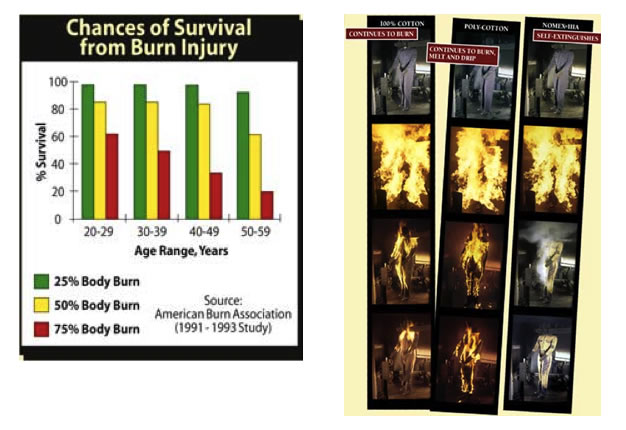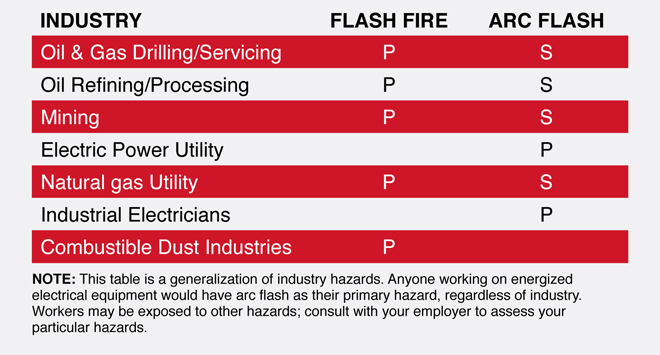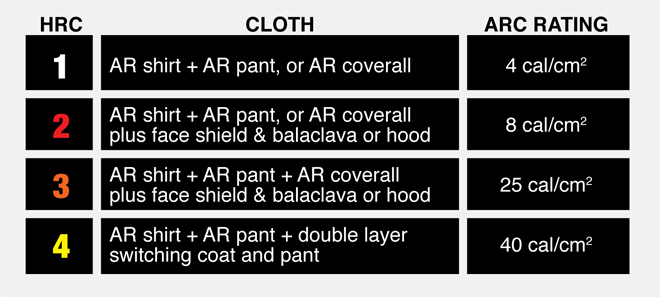FLAME RESISTANT CLOTHING SAVES LIVES.
People working in any industry that has a hazard of clothing igniting
should wear flame-resistant clothing. The bottom line is that FR
clothing saves lives!
Most serious burns from industrial mishaps are caused by regular work
clothing igniting and burning off the wearer's back. Thousands of
clothing-related injuries due to fire occur each year. The most severe
burns are often not caused by the original hazard, but rather are the
secondary result of clothing igniting. FR clothing does not ignite and
continue to burn. Even single-layer FR work clothing can significantly
protect employees..
FR clothing is essentially worn as insurance. In the unlikely event
of a flash fire or electric arc flash or other catastrophe, FR work
clothing reduces burn injury, provides escape time, and increases
chances of survival. Even though a person caught in a flash fire or
electric arc will likely have some injuries, FR clothing can
dramatically reduce their severity. This can mean the difference between
life and death.
Survivors often consider burn injury treatment to be worse than the
burn itself. Treatment and recovery is extremely painful and can take
months if not years. Burn victims can be severely debilitated and
permanently disabled. A survivor's quality of life is dramatically
affected by the extent and severity of burn injury. FR clothing not only
increases the chances of survival, but can significantly enhances the
quality of life after the injury.

CHOOSING THE RIGHT FR GARMENT
KNOW YOUR INDUSTRY'S HAZARDS
There are a number of workplace hazards that have the potential to
ignite work clothing and cause burn injury. Two common hazards are
hydrocarbon flash fires and electric arc flash. This table lists various
industries in which these hazards might be present, either as a primary
(P) or secondary (S) hazard.

NFPA 70E HAZARDS RISK CATEGORY GUIDE
Personal Protective Equipment (PPE) requirements worn by electrical workers and other personnel working around energized parts.

KNOW YOUR INDUSTRY'S STANDARDS
Safety standards have been developed to protect workers from
industrial hazards. Standards related to the performance requirements of
FR garments include:
- NFPA 2112 – Flame-Resistant Garments for Protection of
Industrial Personnel Against Flash Fire: This is a standard for the oil
& gas drilling and petrochemical industries. The standard specifies
the minimum performance requirements and test methods for FR fabrics,
components, and the design and certification requirements for garments
for use in areas at risk of flash fires. It requires FR fabrics to pass a
comprehensive battery of thermal tests, including:
- ASTM D6413 Vertical Flame Test
- ASTM F2700 Heat Transfer Performance (HTP) Test
- Thermal Stability Test
- ASTM F1930 Thermal Mannequin Test
- NFPA 2113 – Selection, Care, Use and Maintenance of
Flame-Resistant Garments for Protection of Industrial Personnel Against
Flash Fire: This standard serves as a user's guide for industrial FR
clothing. It addresses topics such as hazard assessment, purchasing,
cleaning, repairs, storage, decontamination, retiring garments and
proper use procedures. This standard requires that garments be certified
to NFPA 2112.
- NFPA 70E – Electrical Safety in the Workplace: This standard
specifiesrequirements for workplace electrical safety when working on
energized electrical equipment and conductors. It requires the employer
to perform a hazard assessment to determine the potential arc flash
exposure from theequipment, which establishes the arc rating requirement
for the workers' protective clothing. Garments are required to meet the
requirements of ASTM F1506.